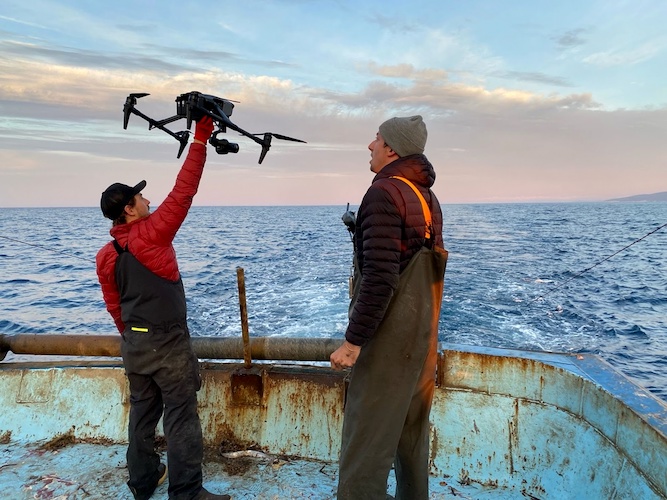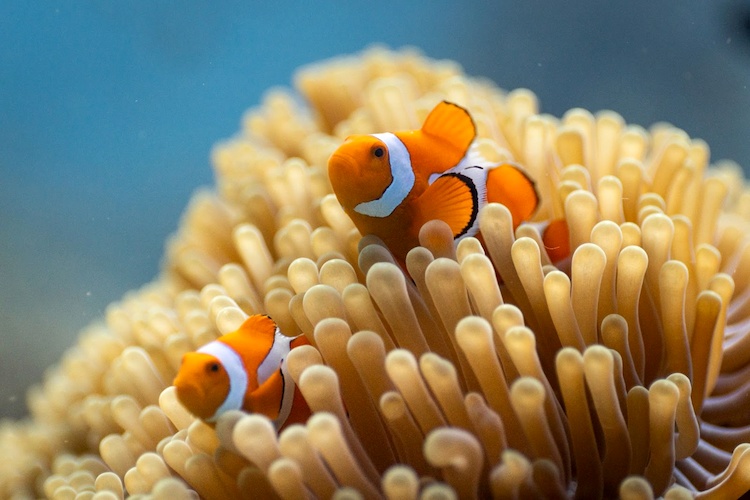How Nat Geo's "Ocean with David Attenborough" Aims to Spark Global Change
In National Geographic’s Ocean with David Attenborough, the legendary naturalist takes viewers on an awe-inspiring journey beneath the waves to reveal the crucial role oceans play in sustaining life on Earth, and how they can recover if we act now. The film, which blends dazzling underwater cinematography with a clear-eyed environmental message, was developed with an urgent purpose. I spoke with executive producers Toby Nowlan and Keith Scholey about the origins of the project, the innovations that made its visuals possible, and the film’s ultimate goal: to inspire protection and hope.
Alex: Hi Keith and Toby, congratulations on the launch of Ocean with David Attenborough. For starters, I was curious if you could talk a little bit about the initial scope of the project, and whether it changed at all based on David's expertise or the things he was passionate about?
Keith Scholey: I’ll just kick off. It’s quite interesting—this is a film that probably never really changed at all. It started as a mission-based film. We knew there was a major UN conference happening in June about protecting 30% of the ocean. And right from the word go, it became a very script-based, story-driven project.
The script fell into place as a way to explain to audiences why ocean protection is so incredibly important. We were all aligned on that. What evolved during the filmmaking process was choosing the best ways to illustrate each point of that journey. There were many choices to be made about the best examples to include, but I think Toby would agree—the actual script and the drive of the film didn’t change at all during the process.
Toby Nowlan: Yeah, absolutely. I mean, very broadly, the story from the get-go was just so strong. The premise was so strong that we kind of knew the overarching narrative from the beginning. It was such a gift. I remember when I started working on it—this idea that we’re living in the greatest age of ocean discovery, even now, and that we’re learning things year after year that are completely changing our understanding of how vital the ocean is for life on Earth.
That realization could change history forever—the discovery of what we’re doing to the ocean, and how we haven’t really seen it before, because it’s never been captured and revealed on screen like this. Part of the story was showing that clearly for the first time. And ultimately, it ends with a message of hope—this incredibly clear resolution that if you protect a third of the ocean, the rest of it fills with life again. That’s just an incredible bit of hope.
Because we knew that from the outset, everything that followed was about refining and funneling the narrative toward that message. Some stories might bubble up that didn’t clearly support it, so we kept focusing on the core. Over three years, we did a lot of fine-tuning—tweaking words, letting stories come and go. The way we filmed things also evolved as we developed new technologies. But yes, uniquely, there was this strong premise from the beginning, and through filming and editing, it all built toward telling that story as clearly as possible.
Alex: One of the things that really struck me was the beauty of the cinematography, especially of things we can’t usually see with the human eye, like the shrimp eggs. Were there any technological innovations that made that photography possible? Or is it more that no one had really looked at those things before?
Toby Nowlan: I think it’s both. There are definitely technological innovations happening all the time in the ocean space. Every year, the amount of time we can spend underwater has been transformed by rebreather apparatus. On the filming side, macro lenses and macro probes keep getting better and better, giving us ever-closer looks at the finer details of sea life.
We also built specific rigs for the film, including something called the “tow cam." It was a torpedo-shaped, tailor-made device with mini cameras in the back, and we hung it off the back of a boat to film ocean travelers in the open ocean. It created a much more immersive experience—you really feel like you're traveling with the animals. It worked beautifully with creatures like the spotted dolphins and false killer whales—they absolutely loved it and just went for it.
And yes, part of it was also choosing to film things that people simply hadn’t focused on before. Take the spiny lobster larvae—that’s an incredible story, tied to lobster fisheries in California and around the world. But the concept of “spillover" had never really been shown clearly on screen before. That became a major mission for us—telling that hopeful story in a way that was easy to grasp.

Alex: Did you get any pushback when trying to shadow dredgers while they were working? Were they curious or resistant, wondering why you wanted to film something so destructive?
Keith Scholey: That’s a very long story. At the start of filming, we actually hoped we could just find archive footage of bottom trawling and dredging. But after an extensive search, there was nothing available—certainly nothing of any quality. And that’s not an accident.
The companies that carry out this kind of activity have wanted it to remain out of sight and out of mind. So yes, it was difficult. We solved the problem by working with scientific teams who were studying the impacts of these practices. Finally, we’re seeing real, detailed research into something that’s been going on for centuries but is incredibly destructive.
We told the scientists, “You’re doing this work already—let us put our cameras on your equipment." That way, they could use the footage to understand their work better, and we could show the world what’s really happening. That was probably the most challenging thing we did, even though it’s such a widespread and long-standing practice.
Toby Nowlan: Bottom trawling was invented here in England 700 years ago. People knew it was damaging even back then. There were complaints to the king about the bycatch being hauled up by little sailboats.
Seven hundred years have gone by, and it’s still happening. Why? Because no one’s ever truly seen it. Bottom trawling is always done blind—boats plow through the seabed without being able to see what they’re doing. So getting that on screen was a major mission.
Alex: And you did capture it well. For a final question, the film ends with a call to action, encouraging viewers to care and to do something. What’s your advice, especially for younger viewers who often feel like their voices don’t carry much weight?
Keith Scholey: I hope what the film does, just from what friends of mine have said after seeing it in cinemas, is teach people things they didn’t know. So step one is education: helping people understand what’s happening in the ocean, and what can be done to save it.
Then, tell others. Spread the word. Let’s get to a place where the broader public really understands how important marine protection is. And hopefully, as more people become aware and that story spreads, it reaches leaders who have the power to act on our behalf.
Because we own the ocean—it’s ours. And the hope is that those in power will make decisions that benefit all of us, not just a small minority of commercial interests.
Alex: Perfect. Thank you, I really appreciate it. Congratulations again!
As Ocean with David Attenborough makes its global debut, Nowlan and Scholey hope the message reaches beyond just the screen. By educating audiences, especially younger viewers, about both the beauty and the peril of the seas, they believe we can help spark a groundswell of public support for marine conservation. After all, as Scholey reminds us, “We own the ocean, it’s ours." And with that ownership comes a responsibility to ensure it flourishes for generations to come.
Ocean with David Attenborough premieres tonight 9/8c on National Geographic and will be available to stream tomorrow on Disney+ and Hulu in celebration of World Oceans Day.


